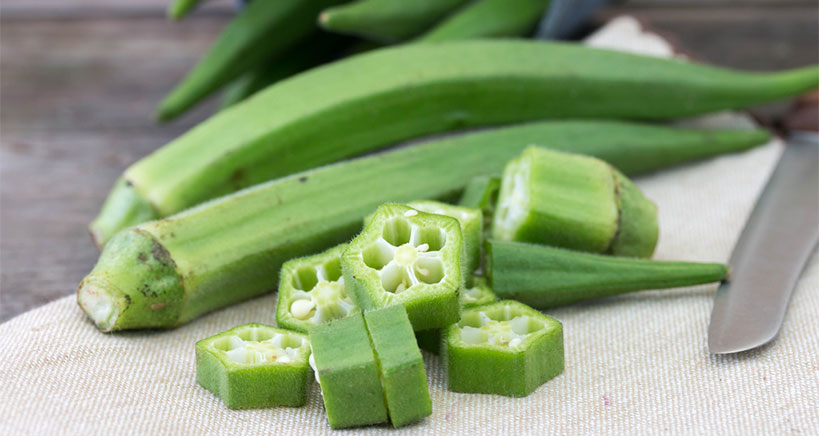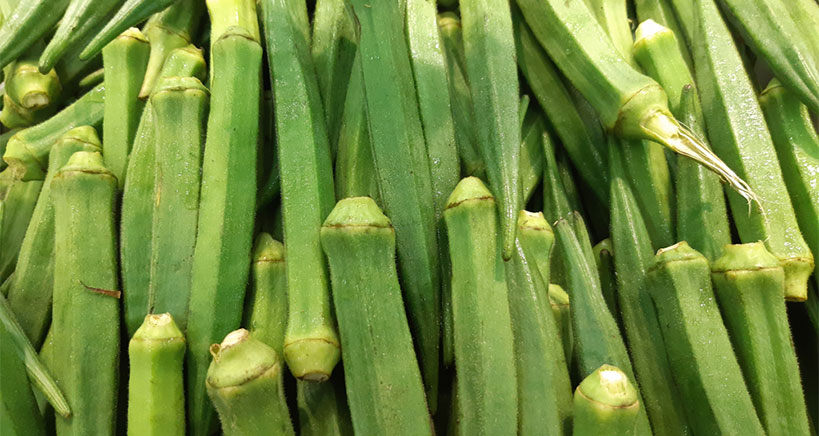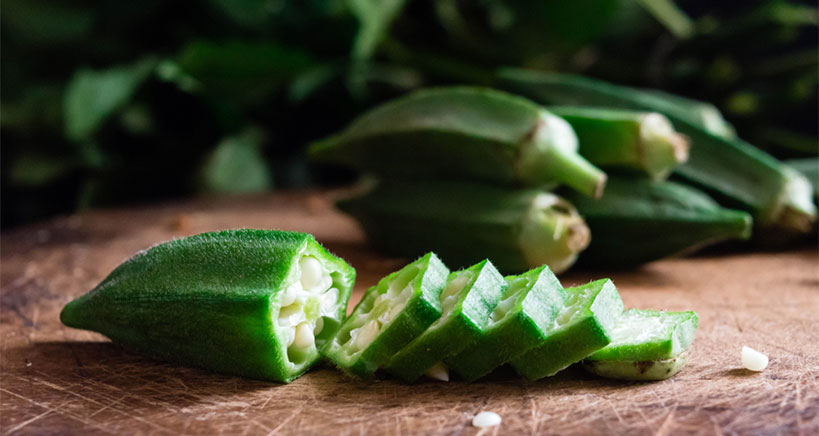
If Okra, Okra seeds, and Okra dishes are not part of your restaurant’s current offerings or something your catering service provides, it’s time for you and your chefs to learn why okra should appear on your menu and how you and your customers can benefit from its many nutritious and tasty properties.
Let’s begin with the basics: What is Okra? A longtime favorite in Southern cooking and originally brought to the U.S. by Ethiopian slaves, Okra is a vegetable that comes from the same plant family as cotton and hibiscus. Also known as “ladies fingers” due to its unique finger shape, it has earned a reputation as a health food and has even been recommended as a way to help manage blood sugar levels in people with diabetes.
Okra: Nutritional Secrets
Nutritionally, okra contains a whole host of oftentimes little-known benefits. Let’s fill in the blanks with the following okra facts:
- Okra is low in calories and high in fiber. making it appealing to all health-conscious customers
- It contains vitamins A and C, as well as B-complex vitamins, including niacin, thiamin, pyridoxine, and pantothenic acid. It also contains potassium, calcium, and thiamin
- It is a good source of folate (known to help prevent birth defects in pregnant women)
- It is a good source of vitamin K, which is good for bones and blood health
- It contains high levels of antioxidants, making it an excellent energy boosting food for on-the-go consumers
- It has been approved by the U.S. Food and Drug Administration for the following descriptors: fat-free, saturated fat-free, very low in sodium, cholesterol-free, a good source of vitamin A, and a good source of magnesium
- Specifically, ½ cup of raw okra contains: 16 calories, 0 grams fat, 2 grams fiber, 41 milligrams calcium, 150 milligrams potassium
Okra’s Claim to Culinary Fame
However, by far okra’s most standout feature and claim to culinary fame is its ‘slimy’ texture, a viscous juice imparted by the vegetable during cooking. While it can be slightly off-putting at first, it is actually this very property that makes okra ideal as a natural thickener when added to soups and stews and which adds a richness to all recipes. The most famous dish made from the vegetable is gumbo, however okra can also be cooked on the stovetop or in the microwave, sautéed, fried, stir-fried, braised, grilled, roasted. And here is insiders’ tip for you: Cooking okra fast and at high temperatures helps get rid of the slime.

Okra Sales Booming
The popularity of ladies’ fingers continues to rise and overall okra sales have now crossed the $20 million mark. As greater numbers of consumers become aware of this Southern cooking staple, you can use its heightened stature as a way to promote your restaurant and boost sales, appealing to ketogenic dieters, vegans, as well as meat lovers! All you need to do is learn how to prepare okra and begin adding it to your menu’s offerings.
And here is some more industry news for both your ‘biz and your customers. High demand for okra has resulted in a significant spike in the global okra seed market. So much so that the latest reports by Market Research Future (MRFR) reveals that the okra seed market is poised to hit $352.7 million by 2023. The heightened interest in okra seeds is also thought to reflect global demands for organic food products, as well as an inclination towards functional foods and ingredients. Your foodservice can take full advantage of these recent tidings by being first in line to feature okra seeds, as well as additional emerging okra products. Some of the savory choices you can now offer your customers include baked okra, dry okra chips, okra water, okra fries, and more.
Buying and Eating Okra
The peak season for fresh okra is May-September, however it is available year round throughout the U.S. If you’ve never seen it before, be on the lookout for its edible seed pods, which appear like peach fuzz on the outside. It comes in both red and green – both of which taste the same – and in fact, the red variety turns green during cooking.
If your chefs are doing the shopping, avoid pods that are shriveled or have brown spots and/or blemishes. But don’t wait too long to use them: You can store okra in the fridge for up to only two-three days, preferably tightly wrapped. With what is described as a mild taste like eggplant, there are many ways to prepare and enjoy okra. So clear your plates, grab your chef’s hat, and let’s get cooking!

Okra Dish Recommendations
- Use okra’s signature viscous juice to thicken soups, sauces, and stews
- Make okra gumbo
- Make okra fries
- Add it to salads
- Serve okra as a side dish to chicken and roasted meat dishes
- Pamper your customers with an okra-tomato salsa-roasted corn dinner
- Look up recipes for okra parmesan, grilled lemon okra, and experiment with creating your own unique twists on this southern favorite
Okra Insiders’ Tips for Foodservice Pros
And now some food industry pro tips: Did you know that you can use dried okra as an egg white substitute? And for a new twist on your customers’ regular morning cup of java, did you know that you can make a non-caffeinated coffee substitute from roasted, ground okra seeds?
Wake Up and Smell the Okra Coffee
If your customers are thirsting for a coffee fix that has no caffeine but still boasts that classic taste and aroma – they’re in luck! Here is how to make Okra Coffee: Heat a small pan over medium-low heat. Add 1 cup of raw okra seeds and roast until dark brown (15-20 minutes), stirring intermittently with a wooden spoon to prevent burning. Using a nut grinder, pulverize the hot, roasted okra seeds into a powder. And voila!

Okra Water
Okra water can be another great addition to your menus as it contains many of the same valuable nutrients as the vegetable. You can even make the H2O yourself by soaking whole pods or thin slices in water overnight. While the drink has a slightly bitter taste this is another way to derive okra’s benefits without eating it.
Freeze Dried Okra
Finally, for a hearty and healthy snack food, add freeze-dried okra to your restaurant or catering service’s inventory, pampering your customers with a crunchy, dried snack that is packed with nutrients. The freeze-drying process removes the juices, leaving a savory snack item that contains (per 1.5 cups of product): 2.5 grams of protein; 10 grams carbohydrate; 3.3 grams fiber; high amounts of vitamins A and C; significant amounts of iron.
Summing Up
So there you have it! The full scoop on ‘Why Okra Should Appear on Your Menu.’ And to top off (and show off) your eatery’s latest offerings, don’t forget to post pictures of your novel okra dishes online, where a singular photo can go viral in a matter of moments, bringing you more business and okra delight than your palate had imagined…